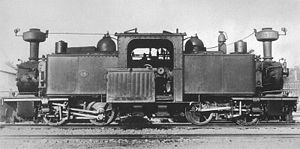Saxon II K
| K.Sächs.Sts.EB. II K | |
|---|---|
| Numbering: | 18, 19 |
| Number: | 2 |
| Manufacturer: | Hawthorn, Leslie & Company , Newcastle |
| Year of construction (s): | 1885 |
| Retirement: | 1903, 1909 |
| Axis formula : | B'B'n4t |
| Gauge : | 750 mm |
| Length over coupling: | 8,948 mm |
| Top speed: | 30 km / h |
| Indexed performance : | k. A. |
| Driving wheel diameter: | 813 mm |
| Control type : | Heusinger |
| Number of cylinders: | 4th |
| Cylinder diameter: | 215 mm |
| Piston stroke: | 355 mm |
| Boiler overpressure: | 10 bar |
| Grate area: | 2x 0.6 m² |
| Water supply: | 2.9 m³ |
| Fuel supply: | 0.9 tons of coal |
| Locomotive brake: | Throw lever brake |
| Train brake: | Lever brake |
The Royal Saxon State Railways designated narrow-gauge Fairlie steam locomotives with a gauge of 750 mm, which were out of service by 1909, as class II K ( read : two K) . In 1913, locomotives of the predecessor type IK were made into two double locomotives, which were also designated as type II K. In the literature, a distinction is made between II K (old) and II K (new) .
history
Since 1881, numerous narrow-gauge lines , some of them with many bends and slopes, have been opened in Saxony , and the volume of traffic has steadily increased. The performance of the IC initially deployed was soon no longer sufficient. Therefore were in 1885 by Leslie & Company Hawthorn, of Newcastle-upon Tyne in England two Fairlie -Lokomotiven delivered at a price of 51,771 marks. Both locomotives were classified in the class Hth F TK , which identified them as Fairlie (F) type tank locomotives (T) with 750 mm gauge (K) made by the manufacturer Hawthorn (Hth). They received the lane numbers 18 or 19. From 1896 was the genre as K II , from 1900 as II K refers.
The locomotives did not prove themselves. Above all, the conditions for the locomotive personnel were completely unreasonable. A downright acrobatic skill was required of the stoker in order to equip both fire boxes in his narrow stoker's position with the necessary coal. In addition, the locomotives were too heavy for most routes.
From another procurement was in favor of the III K class apart. The two loners were retired in 1903 (No. 18) and 1909 (No. 19).
technical features
The vehicles had a double boiler with two standing boilers. They had four wet steam engines with a Heusinger control for each engine. Their top speed was 30 km / h .
literature
- Wolfgang Wagner, Reiner Scheffler: II K (old), III K and VK as well as third-party locomotives on Saxon narrow-gauge railways . Bufe-Fachbuch-Verlag, Egglham 1996, ISBN 3-922138-60-8 .
- Manfred Weisbrod: Saxony Report . Volume 6: Tender and narrow-gauge locomotives, railcars and special designs . Merker, Fürstenfeldbruck 1998, ISBN 3-89610-028-9 ( Eisenbahn-Journal - Archiv 1998, 1).
- Fritz Näbrich, Günter Meyer, Reiner Preuß: Lokomotiv-Archiv Sachsen 2 . transpress VEB publishing house for transport, Berlin 1984.
